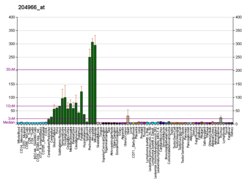Brain-specific angiogenesis inhibitor 2 is a protein that in humans is encoded by the BAI2 gene. It is a member of the adhesion-GPCR family of receptors.
BAI1, a p53-target gene, encodes brain-specific angiogenesis inhibitor, a seven-span transmembrane protein and is thought to be a member of the secretin receptor family. Brain-specific angiogenesis proteins BAI2 and BAI3 are similar to BAI1 in structure, have similar tissue specificities and may also play a role in angiogenesis.
References
- ^ GRCh38: Ensembl release 89: ENSG00000121753 – Ensembl, May 2017
- ^ GRCm38: Ensembl release 89: ENSMUSG00000028782 – Ensembl, May 2017
- "Human PubMed Reference:". National Center for Biotechnology Information, U.S. National Library of Medicine.
- "Mouse PubMed Reference:". National Center for Biotechnology Information, U.S. National Library of Medicine.
- Shiratsuchi T, Nishimori H, Ichise H, Nakamura Y, Tokino T (Apr 1998). "Cloning and characterization of BAI2 and BAI3, novel genes homologous to brain-specific angiogenesis inhibitor 1 (BAI1)". Cytogenet Cell Genet. 79 (1–2): 103–8. doi:10.1159/000134693. PMID 9533023.
- ^ "Entrez Gene: BAI2 brain-specific angiogenesis inhibitor 2".
- Stacey, edited by Simon Yona, Martin (2010). Adhesion-GPCRs : structure to function. New York: Springer Science+Business Media. ISBN 9781441979124.
{{cite book}}:|first=has generic name (help)CS1 maint: multiple names: authors list (link)
External links
- Human ADGRB2 genome location and ADGRB2 gene details page in the UCSC Genome Browser.
Further reading
- Kreienkamp HJ, Zitzer H, Gundelfinger ED, et al. (2000). "The calcium-independent receptor for alpha-latrotoxin from human and rodent brains interacts with members of the ProSAP/SSTRIP/Shank family of multidomain proteins". J. Biol. Chem. 275 (42): 32387–90. doi:10.1074/jbc.C000490200. PMID 10964907.
- Kee HJ, Koh JT, Kim MY, et al. (2002). "Expression of brain-specific angiogenesis inhibitor 2 (BAI2) in normal and ischemic brain: involvement of BAI2 in the ischemia-induced brain angiogenesis". J. Cereb. Blood Flow Metab. 22 (9): 1054–67. doi:10.1097/00004647-200209000-00003. PMID 12218411.
- Petersen HH, Hilpert J, Militz D, et al. (2003). "Functional interaction of megalin with the megalinbinding protein (MegBP), a novel tetratrico peptide repeat-containing adaptor molecule". J. Cell Sci. 116 (Pt 3): 453–61. doi:10.1242/jcs.00243. PMID 12508107.
- Adkins JN, Varnum SM, Auberry KJ, et al. (2003). "Toward a human blood serum proteome: analysis by multidimensional separation coupled with mass spectrometry". Mol. Cell. Proteomics. 1 (12): 947–55. doi:10.1074/mcp.M200066-MCP200. PMID 12543931.
- Nagaraja GM, Kandpal RP (2004). "Chromosome 13q12 encoded Rho GTPase activating protein suppresses growth of breast carcinoma cells, and yeast two-hybrid screen shows its interaction with several proteins". Biochem. Biophys. Res. Commun. 313 (3): 654–65. doi:10.1016/j.bbrc.2003.12.001. PMID 14697242.
- Ota T, Suzuki Y, Nishikawa T, et al. (2004). "Complete sequencing and characterization of 21,243 full-length human cDNAs". Nat. Genet. 36 (1): 40–5. doi:10.1038/ng1285. PMID 14702039.
- Bjarnadóttir TK, Fredriksson R, Höglund PJ, et al. (2005). "The human and mouse repertoire of the adhesion family of G-protein-coupled receptors". Genomics. 84 (1): 23–33. doi:10.1016/j.ygeno.2003.12.004. PMID 15203201.
This article incorporates text from the United States National Library of Medicine, which is in the public domain.
| Cell surface receptor: G protein-coupled receptors | |||||||||||||||||||||||||||||||||||
|---|---|---|---|---|---|---|---|---|---|---|---|---|---|---|---|---|---|---|---|---|---|---|---|---|---|---|---|---|---|---|---|---|---|---|---|
| |||||||||||||||||||||||||||||||||||
| |||||||||||||||||||||||||||||||||||
| |||||||||||||||||||||||||||||||||||
| |||||||||||||||||||||||||||||||||||
This transmembrane receptor-related article is a stub. You can help Misplaced Pages by expanding it. |




